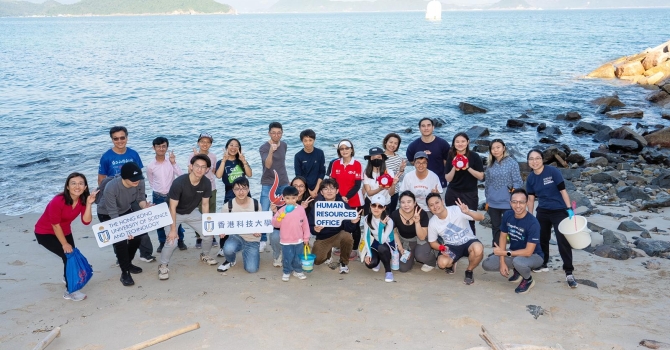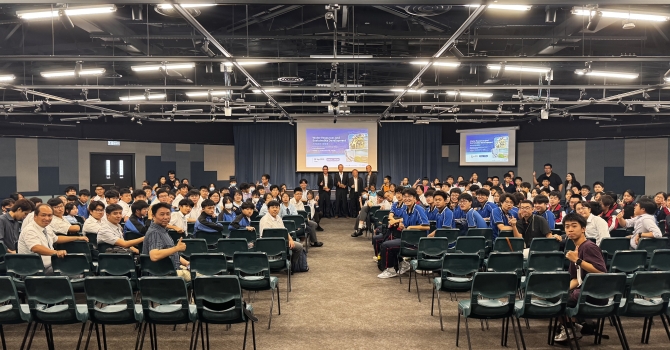Forging Friendships and Innovative Solutions at HKUST’s Sustainable Design Thinking Workshop
Who knew 7 days at the Clear Water Bay campus were all it took to sow another success from The Sustainable Design Thinking Certificate Program? This year’s program received generous support from The Tung Foundation, under the HKUST2.0 framework aimed to truly integrate HKUST (Clear Water Bay) and the HKUST (Guangzhou).
Organized by HKUST Sustainability / Net-Zero Office, the Vice-President (Teaching & Learning) Office (HKUST (GZ)), and the Academy of Interdisciplinary Studies, the week-long workshop brought together a diverse group of 22 undergraduates and post-graduates from each of the two campuses. A key objective of the program was building friendship across disciplines and culture, learning teamwork, sustainability integration skills, equipping the students for the future work environment. Participants went through a series of workshops and team activities with the aim of solving sustainability problems concerning university stakeholders.
The program served as a melting pot for participants with different perspectives of the ideal HKUST Sustainable Smart Campus (HKUST SSC). During the seven days, participants went through a series of workshops and team activities—brainstorming, field survey and prototyping sessions which were led by skillful academic faculties, HKUST operation and counseling center staff, and external industry professionals. The Design Thinking mindset was reinforced throughout the entire program, grounding students to ensure that their solutions are tailored to the university’s needs.
“The program was intense and fruitful. Students teamed up with peers from diverse background and used design thinking to come up with interesting solutions to solve real-world sustainability problems on campus. They made new friends and left a lot of laughter along the way. I am so proud of them.”
– Dr. Zhang Rong, Division of Emerging Interdisciplinary Areas, Academy of Interdisciplinary Studies
The 6 project ideas that were bred during the program were concerned about 3 main themes : Health and Wellbeing, Waste Management and Clean Energy Generation.
The winning team, Polarbrella, proposed a net zero umbrella with a cooling system and charging function to be attached to outdoor sitting areas. “Our smart solar umbrella will be covered with perovskite, which is a flexible material that turns solar energy into electricity. That way, students can sit outdoors, enjoy the view, study and hang out with friends despite the scorching hot weather in cruel summer. We hope to contribute to a nice outdoor environment for student well-being, and also align with the net zero carbon goals of the school”, Ler Yin of GZ campus said when asked about her team’s project.
The first runner up project, USTMood, focused on health and wellbeing of HKUST students. It takes form as a digital mood tracking system aiming to be the voice of students silently shouting for help. A member of the first runner-up project, Xi Miaowei of the GZ campus wrote, “This educational journey provided me with an in-depth understanding of various aspects of campus sustainability, and I actively engaged in a project focused on promoting mental health on our campus. Importantly, through our collaboration with the students of the Clear Water Bay campus, we have deepened our bonds and achieved growth through shared laughter”.
SSCoin, an initiative to differentiate between recyclables and non-recyclables by using a scanning system came third in the contest.
Another team, One Punch, impressed the judges by making recycling fun, touching upon both the topics of wellbeing and education in waste management at once. The project won the Best Prototype Award. “The best takeaways from these seven days, is the process of design thinking, which is the human-centred approach, instead of just thinking about what we want to achieve, we need to empathize with our user and design a product they really need,” and to Michael Lee (CWB campus) and his team, this meant constructing a highly interactive prototype.
“The judging criteria placed emphasis on empathy, creativity, feasibility and systems thinking. The judges had a tough time deliberating between the very strong and passion-filled submissions. The winning projects stood out as they combined existing elements in an unique, interesting and integrated manner, had a well thought out implementation plan, while meeting our aspirations towards improving wellbeing, waste and carbon emissions. We look forward to incorporating some of the interesting ideas for future implementation on campus.”
– Judge, Teri Tan, Sustainability / Net-Zero Office
Kenrick LI, an executive MBA student from the CWB campus shared, “The Sustainable Design Thinking Program week was a fantastic way to learn about the design thinking process and life cycle systems as someone with no prior experience. Having access to high level stakeholder presentations and interview time added tremendous value, allowing a better understanding of the current challenges and how to begin addressing them.”
By empowering students as partners in eco-innovation, HKUST is laying the groundwork for a more resilient and circular campus community.
“What Sustainable Design Thinking has brought to me, besides the learning in the course itself, is that I have also met a lot of excellent and interesting classmates. The collision of different backgrounds and experiences brought a lot of new sparks.”
– Byorn, MPhil student HKUST (CWB)
It had been a great experience for the students and we hope that they can keep the relationships and networks after the program. This tradition of cross-campus engagement and learning will be continued. “I am excited to announce that next year, the program will be held in Guangzhou”, declared Prof. Chan Man, the Head of Base of Red Bird MPhil (HKUST (GZ)) in his speech last Tuesday.
For program highlight, check out our video by clicking here.
You can watch the videos of the winning teams by checking out here.
Our talented participants brought their prototypes to life, showcasing their hard work to a panel of judges at the final presentation ceremony! Check out the recap video now.


